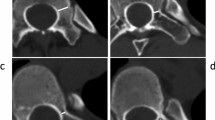Abstract
Study design
Postoperative outcomes of segmental pedicle screw fixation were evaluated in posterior scoliosis surgery with the use of navigation system.
Objectives
We report the usefulness of a navigation system and a segmental pedicle screw fixation in surgery for scoliosis.
Summary of background data
Few reports on a segmental pedicle screw fixation method for scoliosis surgery using a navigation system have been published. This is the report on the usefulness of a navigation system in segmental pedicle screw fixation.
Methods
We targeted 16 cases in which segmental pedicle screw fixation had been performed using a navigation system at our hospital. We inserted 264 pedicle screws in total, and we did not perform registration for each corpus vertebrate in order to shorten the duration of the surgery. We reviewed screw deviation among the items for review using Neo classification with postoperative CT images (1.25 mm). For screw deviation in this case, grade 2 or higher in the Neo classification system was designated as total deviation. Furthermore, we evaluated the registration period per corpus vertebrae, the complications, duration of surgery, blood loss, Cobb angle, and the correction rate.
Results
In terms of screw deviation, 11 (4.2%) of the 264 inserted screws were classified as total deviation. However, there were no neurovascular complications during or after surgery in any cases, and all cases maintained strong internal fixation. In the relationship between the use or nonuse of registration and the deviation, four screws (3.2%) in the corpus vertebrae for which registration was performed and seven screws (5.0%) in the adjacent corpus vertebrae for which registration was not performed had deviated. The duration of registration per corpus vertebrate averaged 4 min and 24 s (58–791 s), but registration also requires a learning curve, so the duration of registration per corpus vertebrae averaged 1 min and 14 s in more recent cases, thus marking a significant shortening.
Conclusion
Segmental pedicle screw fixation are excellent in regard to their fixing and correction force and have been clinically applied even in surgery for scoliosis, but the potential risk of neurovascular complications is unavoidable. The adoption of a navigation system in surgery for scoliosis is useful to increase the safety and certainty of the insertion of pedicle screws.






Similar content being viewed by others
References
Suk SI, Lee CK, Kim WJ et al (1995) Segmental pedicle screw fixation in the treatment of thoracic idiopathic scoliosis. Spine 20:1399–1405. doi:10.1097/00007632-199506000-00012
Suk SI, Lee SM, Chung ER et al (2005) Selective thoracic fusion with segmental pedicle screw fixation in the treatment of thoracic idiopathic scoliosis: more than 5-year follow-up. Spine 30:1602–1609. doi:10.1097/01.brs.0000169452.50705.61
Kotani Y, Abumi K, Ito M et al (2007) Accuracy analysis of pedicle screw placement in posterior scoliosis surgery: comparison between conventional fluoroscopic and computer-assisted technique. Spine 32:1543–1550. doi:10.1097/BRS.0b013e318068661e
Lonstein JE, Denis F, Perra JH et al (1999) Complications associated with pedicle screws. J Bone Joint Surg Am 81:1519–1528
Minor ME, Morrissey NJ, Peress R et al (2004) Endovascular treatment of an iatrogenic thoracic aortic injury after spinal instrumentation: case report. J Vasc Surg 39:893–896. doi:10.1016/j.jvs.2003.10.056
Papin P, Arlet V, Marchesi D et al (1999) Unusual presentation of spinal cord compression related to misplaced pedicle screws in thoracic scoliosis. Eur Spine J 8:156–160. doi:10.1007/s005860050147
West JL, Ogilvie JW, Bradford DS (1991) Complications of the variable screw plate pedicle screw fixation. Spine 16:576–579. doi:10.1097/00007632-199105000-00016
Rajasekaran S, Vidyadhara S, Shetty AP (2007) Randomized clinical study to compare the accuracy of navigated and non-navigated thoracic pedicle screws in deformity correction surgeries. Spine 32:56–64. doi:10.1097/01.brs.0000252094.64857.ab
Lenke LG, Betz RR, Harms J et al (2001) Adolescent idiopathic scoliosis: a new classification to determine extent of spinal arthrodesis. J Bone Joint Surg Am 83:1169–1181
Liljenqvist UR, Link TM, Halm HF (2000) Morphometric analysis of thoracic and lumbar vertebrae in idiopathic scoliosis. Spine 25:1247–1253. doi:10.1097/00007632-200005150-00008
Sugimoto Y, Tanaka M, Nakanishi K et al (2007) Predicting intraoperative vertebral rotation in patients with scoliosis using posterior elements as anatomical landmarks. Spine 32:761–763
Goto M, Kawakami N, Matsubara Y et al (1999) Vertebral rotation in scoliosis interobserver error and intraobserver error of the Aoro’s method. J Jpn Scoliosis Soc 14:1429–1432
Azuma S, Shimode M (2002) Scoliosis surgery using computer-assisted image guidance system. J Jpn Rheumatol 28:251–259
Kim YJ, Lenke LG, Kim J et al (2006) Comparative analysis of pedicle screw versus hybrid instrumentation in posterior spinal fusion of adolescent idiopathic scoliosis. Spine 31:291–298. doi:10.1097/01.brs.0000197865.20803.d4
Zeiller SC, Lee J, Lim M et al (2005) Posterior thoracic segmental pedicle screw instrumentation: evolving methods of safe and effective placement. Neurol India 53:458–465
Liljenqvist UR, Halm HF, Link TM (1997) Pedicle screw instrumentation of the thoracic spine in idiopathic scoliosis. Spine 22:2239–2245. doi:10.1097/00007632-199710010-00008
Brown CA, Lenke LG, Bridwell KH et al (1998) Complications of pedicle thoracolumbar and lumbar pedicle screws. Spine 23:1566–1571. doi:10.1097/00007632-199807150-00012
Lehman RA, Lenke LG, Keeler KA et al (2007) Compted tomography evaluation of pedicle screws placed in the peadiatric deformed spine over an 8-year period. Spine 32:2679–2684. doi:10.1097/01.brs.0000259211.22036.2a
Author information
Authors and Affiliations
Corresponding author
Rights and permissions
About this article
Cite this article
Nakanishi, K., Tanaka, M., Misawa, H. et al. Usefulness of a navigation system in surgery for scoliosis: segmental pedicle screw fixation in the treatment. Arch Orthop Trauma Surg 129, 1211–1218 (2009). https://doi.org/10.1007/s00402-008-0807-3
Received:
Published:
Issue Date:
DOI: https://doi.org/10.1007/s00402-008-0807-3




